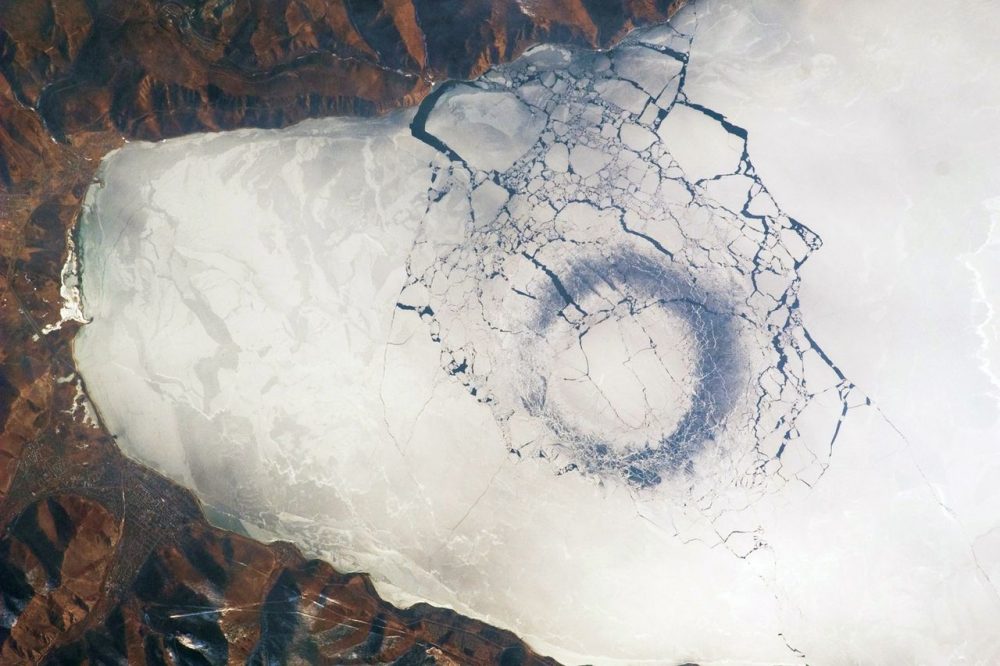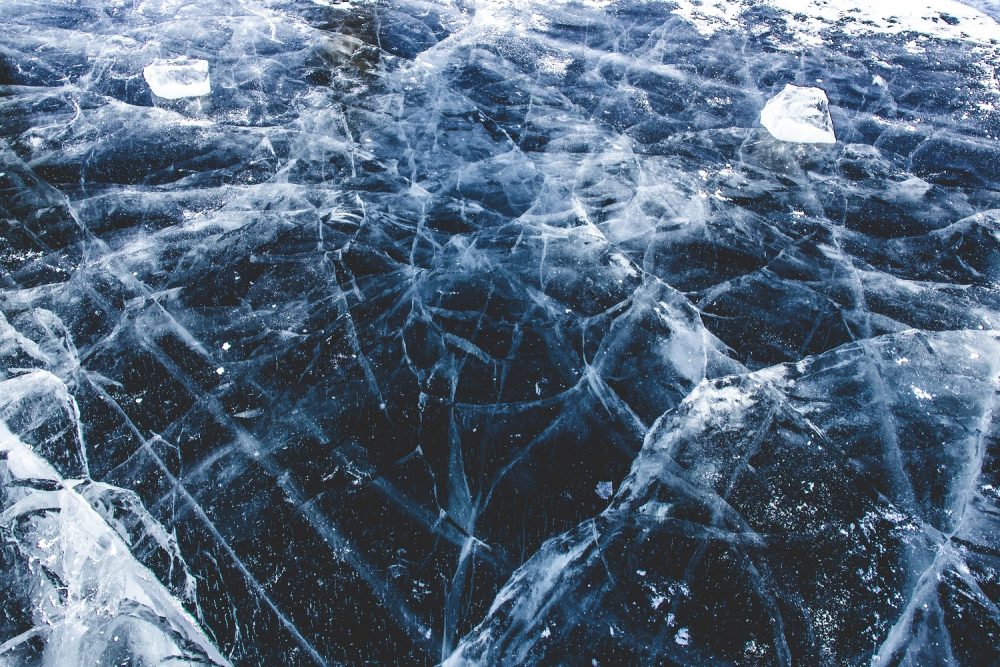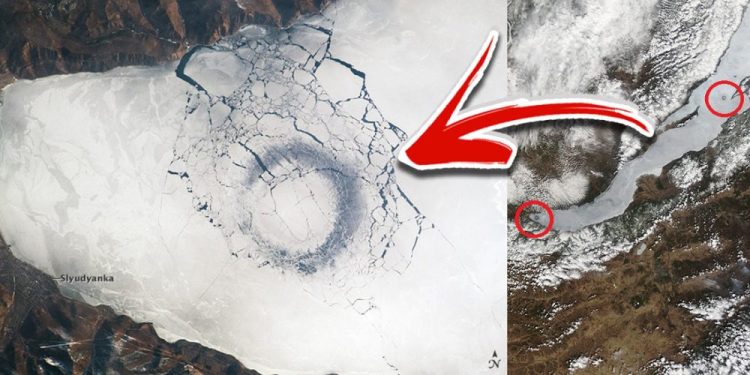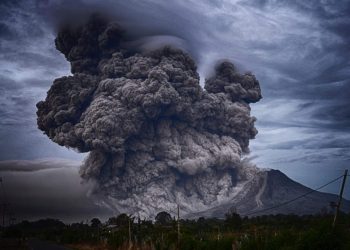Lake Baikal in southern Siberia holds more water than any other freshwater lake in the world. Its depth of 1,642 meters and age—estimated at up to 30 million years—make it both the oldest and deepest lake on the planet. It contains about 20% of the world’s unfrozen freshwater, more than all five Great Lakes combined.
But beneath its crystal-clear surface lies something even more intriguing than its geological history: a record of unusual sightings, unexplained disappearances, and long-standing stories of strange encounters that have never been fully explained.
Lake Baikal has long been a sacred place for locals, often described in folklore as alive or sentient. Yet in recent decades, attention has shifted from ancient legends to modern mysteries—including glowing orbs, unexplained ship vanishings, and strange figures reportedly encountered underwater.

Cosmonauts saw massive circles on the ice from space
In April 2009, astronauts aboard the International Space Station observed enormous circular patterns on Lake Baikal’s frozen surface. The images, later published by NASA, showed giant rings spanning several kilometers. No official explanation was ever confirmed.
NASA scientists speculated that convection currents—warm water rising from the depths—could be responsible. Some researchers pointed to hydrothermal activity beneath the lake, but the rings appeared in deep areas not known for volcanic heat flow. The result is a mystery still debated today.
Lake Baikal is known for its rapid ice cover changes, extreme winter cold, and occasional geothermal vents, all of which can cause natural anomalies. But patterns of that size, visible from orbit, remain unusual even by Siberian standards.
Encounters reported by divers, villagers, and researchers
The lake’s strange reputation deepened in 1982 during a Soviet military diving expedition. According to Russian historian Alexey Tivanenko, seven divers were conducting a routine training exercise at about 50 meters depth when they encountered humanoid beings described as three meters tall, wearing tight-fitting suits and helmets. The divers tried to capture the entities, but the mission went wrong. Several were injured during an emergency ascent, and at least one diver reportedly died. The Soviet military has never officially acknowledged the event. And to be honest I believe this is just one of those attention-grabbing conspiracies.
However, the conspiracy doesn’t stop there. Stories of bizarre underwater encounters are not limited to that incident. In 1977, scientists V. Alexandrov and G. Seliverstov explored the lake’s floor in a submersible. At a depth of 1,200 meters, they saw what appeared to be a powerful beam of light approaching their vessel. The sub lost power temporarily. Only after the beam vanished did their systems return to normal.
These stories are difficult to verify, but they form a consistent pattern in Lake Baikal’s long history of strange phenomena. Some reports have been included in declassified Soviet documents, suggesting the military took the sightings seriously—even if publicly, they remained silent.
Eyewitnesses recall enormous flying objects and glowing lights
One of the most widely shared sightings took place near the village of Kurma on April 17, 1987. Valery Rudenstovsky, a local resident, described what he and 12 others saw that night:
“There was 13 of us. At about 12:20 a.m., one of our guys went out into the yard, a few seconds later runs, and calls all of us out. He stood in the center of the yard and pointed his finger at the sky. Diagonally from his gesture—150 meters above us—hung a huge flying saucer. From the center of the plate went a phosphorescent purple ray. And at the edges of the plate were yellow portholes, almost like in our rural houses. The diameter of the plate was 70 meters. We saw it so clearly and for a long time, someone even suggested he throw a stone at it…”
“The weather was amazingly quiet, no sound was heard from the hanging saucer… It was a full moon and the visibility was so clear that no one of us could doubt the reality of what we saw.”
The craft reportedly drifted along the shore and then vanished into the hills. Rudenstovsky and others claim that sightings like these aren’t rare. Local hunters and fishermen have described similar events, including glowing spheres or disk-shaped objects rising from the lake’s surface and shooting into the sky.

A boat vanished without a trace in 2011
Lake Baikal’s mysteries aren’t limited to flying objects. In 2011, a boat named Yamaha left the village of Kabansk with four experienced sailors on board. They were testing a new engine and remained well within cellphone range. But shortly after entering a fog bank, all contact was lost. The boat disappeared completely.
Despite extensive search and rescue efforts, no wreckage or bodies were ever recovered. The lake was calm, the weather uneventful, and the sailors had modern equipment. Their disappearance remains unexplained.
Such vanishings have fueled the lake’s reputation as a kind of “Siberian Bermuda Triangle.” Stories of ships going missing and objects “materializing” on the surface are common. Some locals even claim to have seen castles or trains appear on the frozen lake—phenomena likely caused by rare atmospheric mirages known as superior refraction. In cold regions like Siberia, light can bend across layers of warm and cool air, making distant or imaginary objects appear real.
Decades of mystery with no clear answers
Lake Baikal continues to attract scientists, adventurers, and mystery-seekers alike. While some of its phenomena have potential natural explanations—like geothermal activity, atmospheric optics, or tectonic stress—many of the stories remain stubbornly unresolved.
Whether it’s the declassified files from the Soviet era, strange sonar readings from the lake’s depths, or firsthand accounts of flying discs and humanoid swimmers, the legend of Lake Baikal has grown far beyond its geological significance. For those who’ve seen its secrets up close, the explanations—if they exist—remain buried deep beneath the ice.











